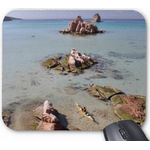This stage includes the route from San Borja to Santa Rosa along a road that goes through several estancias where hunting is prohibited. As a result, the amount of wildlife is significantly higher and the sightings are a lot more frequent. We arrive in Santa Rosa during the festivities of its patron saint and we have the opportunity to witness several of the activities for the celebration. The canoe ride through the Pampas of the Yacuma River in the municipal protected area is simply amazing. We see lots of wildlife of all kinds and very, very close. From Santa Rosa we go to Rurre, the tourist capital of the Bolivian Amazon and the gateway to Madidi National Park. This park was one of the must-see from the beginning of the trip but after the negative experience of the Beni Reserve, the disappointment of some travelers we found in Rurre and the inflated prices, we decide not to visit it. In Rurre we collect our precious mega-bag and take a bus to Cobija, on the northern border with Brazil. From there we cross to the country of samba.
Stage index:
August 27, 2011: From San Borja to Estancia San Vicente
August 28, 2011: From Estancia San Vicente to Santa Rosa
August 29, 2011: Santa Rosa festivities
August 30, 2011: Visit to the Pampas del Yacuma Reserve
August 31, 2011: Santa Rosa del Yacuma
From September 1 to 3, 2011: From Santa Rosa to Rurrenabaque
From September 4 to 5, 2011: From Rurre to Cobija and Epitaciolândia
Profile for the entire stage (San Borja - Santa Ana - Rurrenabaque):

August 27, 2011: From San Borja to Estancia San Vicente
Our initial plan was to go to Rurrenabaque from San Borja to visit the famous Madidi National Park. However, the prices of the organized tours and the advice of the inhabitants of San Borja have made us change course. Instead, we go to Santa Rosa through a road where you can see “lots of caimans”, according to the locals. The road crosses several estancias of the same owner, who forbids hunting.

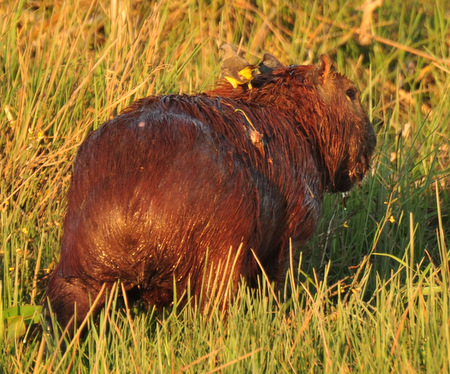 Most of the route today is boring, on a dusty and sandy road, with no interesting wildlife. Judit spots what seems like an antelope, but it hides among the vegetation quickly. In the afternoon, after crossing the barrier of the prohibited hunting zone, we start to see lots of alligators. In almost all the large enough pools there is at least a couple. Some concentrate up to 12. They can be easily observed basking in the sun, a few yards from the road, usually with the head near the water. When the sun goes down we spot a pair of capybaras cooling in a pond.
Most of the route today is boring, on a dusty and sandy road, with no interesting wildlife. Judit spots what seems like an antelope, but it hides among the vegetation quickly. In the afternoon, after crossing the barrier of the prohibited hunting zone, we start to see lots of alligators. In almost all the large enough pools there is at least a couple. Some concentrate up to 12. They can be easily observed basking in the sun, a few yards from the road, usually with the head near the water. When the sun goes down we spot a pair of capybaras cooling in a pond.
Later we get a flat and for some reason we still don’t yet understand, the rear hub gets damaged and cannot be tighten enough to hold the wheel to the frame. Why these things have to happen when it’s getting dark? Eventually, we solve it by adding a pair of thick metal plates that we never thought would be useful. With so much alligator around we don’t feel comfortable camping out there, so we rush to get to the Estancia San Vicente, where we pitch the tent when it’s almost dark. Although the sun has set, the heat is still stifling. Today for the first time, we assemble the tent without the rainfly but we are still sweating until well into the night.
Go to top
August 28, 2011: From Estancia San Vicente to Santa Rosa
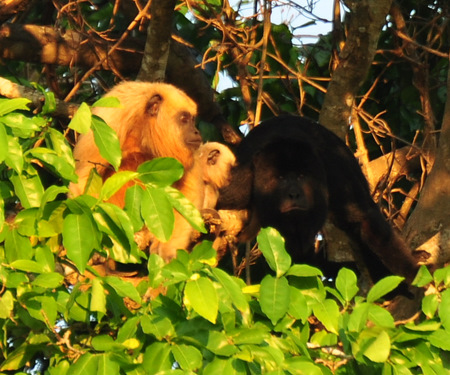 Ready to take advantage of the cool morning, we wake up before dawn. When we leave the tent with everything ready, a red sun appears on the horizon. From the island forest near the road we hear the hoarse calls of a group of howler monkeys. When we get back to the road, we hear them nearer, closer than 100 yards. We move the bikes aside of the road and enter the forest. On the branches of a large tree we see a family warming up in the morning sun. The male is black and the female and her young baby are blond. Although we are about 35 yards away, when we move to an opening between the palm trees, they hide deeper in the branches. The female moves from tree to tree slowly with the baby clinging to her back and her tail curled up in Mom's tail. From the top they watch us feeling safe. We stop bothering them and return to the bikes to go back to the road.
Ready to take advantage of the cool morning, we wake up before dawn. When we leave the tent with everything ready, a red sun appears on the horizon. From the island forest near the road we hear the hoarse calls of a group of howler monkeys. When we get back to the road, we hear them nearer, closer than 100 yards. We move the bikes aside of the road and enter the forest. On the branches of a large tree we see a family warming up in the morning sun. The male is black and the female and her young baby are blond. Although we are about 35 yards away, when we move to an opening between the palm trees, they hide deeper in the branches. The female moves from tree to tree slowly with the baby clinging to her back and her tail curled up in Mom's tail. From the top they watch us feeling safe. We stop bothering them and return to the bikes to go back to the road.
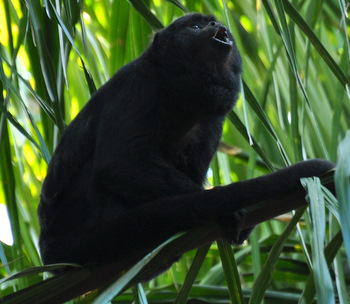 We pass the edge of the forest island and hear more howling from another group. We move into the trees again and a male shouts effusively. A couple of palm trees away there is a female and perhaps a baby, but we only see the branches moving. The male doubles his howling directed at us until the female crosses the branches to where he is. At that time, we go away and his agitation finally decreases. We are a little surprised by their attitude as they live right next to the houses of the estancia and should be used to human presence.
We pass the edge of the forest island and hear more howling from another group. We move into the trees again and a male shouts effusively. A couple of palm trees away there is a female and perhaps a baby, but we only see the branches moving. The male doubles his howling directed at us until the female crosses the branches to where he is. At that time, we go away and his agitation finally decreases. We are a little surprised by their attitude as they live right next to the houses of the estancia and should be used to human presence.
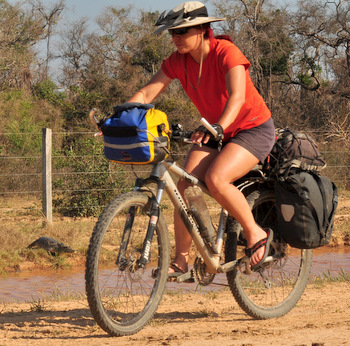 Along the way we see many alligators, some of them a few feet from the dirt road. In almost all ponds there are little eyes poking above the water surface. When we look closely at some of the lagoons, we always find more than the ones we see at first glance, creating a feeling of insecurity. How many are there really? Are you sure that there isn’t one right in front of your feet? Move the mouse over the picture to the left...
Along the way we see many alligators, some of them a few feet from the dirt road. In almost all ponds there are little eyes poking above the water surface. When we look closely at some of the lagoons, we always find more than the ones we see at first glance, creating a feeling of insecurity. How many are there really? Are you sure that there isn’t one right in front of your feet? Move the mouse over the picture to the left...
In general, the road gets better, but there are still long sandy stretches. Also, a section of the road goes into the grasslands, as some of the wooden bridges have fallen. In this area, the dried mud terrain has lots of potholes due to livestock tracks. It’s already noon and the last few miles to Santa Rosa become hard due to the overwhelming heat. After the ferry across the Yacuma River, a wasp trapped between Judit’s back and her shirt bites her. She slaps the wasp and crushes it, but it is too late. Luckily the intense pain only lasts a few minutes and then we resume our ride after a short rest.
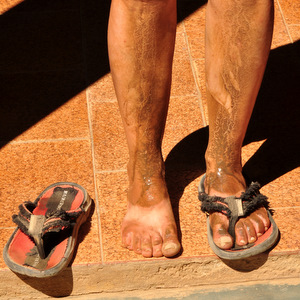 We take advantage of every shade to stop and hydrate. A few miles from Santa Rosa, the road significantly improves and allows us to ride faster. In the room of the hotel, the ceiling fan spins at full speed to move the hot air and give a feeling of coolness. We are not leaving from here until the temperature goes below 95F.
We take advantage of every shade to stop and hydrate. A few miles from Santa Rosa, the road significantly improves and allows us to ride faster. In the room of the hotel, the ceiling fan spins at full speed to move the hot air and give a feeling of coolness. We are not leaving from here until the temperature goes below 95F.
Go to top
August 29, 2011: Santa Rosa festivities
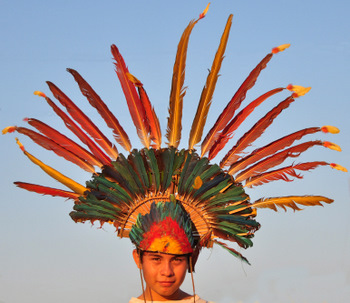 Either in Bolivia there are folkloric festivals all the time or we are lucky to reach villages when they are celebrating them. Tomorrow is the festivity of Santa Rosa and the village is celebrating their patron saint. Probably, the rest of the year, Santa Rosa de Yacuma is a quiet town that moves at a slow pace, dedicated to the cattle industry. Now each of the terraces on the plaza is defended by one-men-band armed with a keyboard and loudspeakers of many watts. The volume is deafening, but as most customers are half drunk, they don’t care. Beer bottles are stacked on their tables. A cold beer feels so good with this heat…
Either in Bolivia there are folkloric festivals all the time or we are lucky to reach villages when they are celebrating them. Tomorrow is the festivity of Santa Rosa and the village is celebrating their patron saint. Probably, the rest of the year, Santa Rosa de Yacuma is a quiet town that moves at a slow pace, dedicated to the cattle industry. Now each of the terraces on the plaza is defended by one-men-band armed with a keyboard and loudspeakers of many watts. The volume is deafening, but as most customers are half drunk, they don’t care. Beer bottles are stacked on their tables. A cold beer feels so good with this heat…
 We have to wait until tomorrow to visit the Municipal Protected Area of the Pampas of the Yacuma and today we are devoted to organizational tasks. In the afternoon and at night there are several events in the plaza: dances, parades, costumes... Here again we see a group that plays rattles and spin around themselves while dancing. The clothes are more like a costume. We still don’t know what they are. We are lucky to see the macheteros dance, probably the most famous dance from Beni, originally from San Ignacio de Moxos. The men wear on their heads semicircular crowns made of spectacular and colorful macaw tail feathers. Before we go to sleep we improve some more our ability of reading lips having a beer in one of the terraces while the thunderous speakers burst the eardrums of the customers next to them. It may be a technique to accelerate beer consumption. As you cannot have a conversation, you just drink.
We have to wait until tomorrow to visit the Municipal Protected Area of the Pampas of the Yacuma and today we are devoted to organizational tasks. In the afternoon and at night there are several events in the plaza: dances, parades, costumes... Here again we see a group that plays rattles and spin around themselves while dancing. The clothes are more like a costume. We still don’t know what they are. We are lucky to see the macheteros dance, probably the most famous dance from Beni, originally from San Ignacio de Moxos. The men wear on their heads semicircular crowns made of spectacular and colorful macaw tail feathers. Before we go to sleep we improve some more our ability of reading lips having a beer in one of the terraces while the thunderous speakers burst the eardrums of the customers next to them. It may be a technique to accelerate beer consumption. As you cannot have a conversation, you just drink.
Go to top
August 30, 2011: Visit to the Pampas del Yacuma Reserve

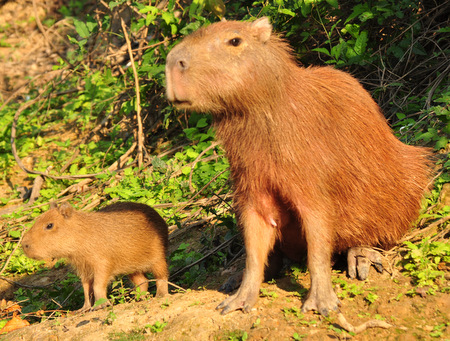 At 6:30 AM, Luis (aka the Cricket) comes to our hotel to pick us up with a motorcycle taxi, accompanied by another motorbike. We ride with them to Puerto Tucumán, in the Yacuma River. There awaits his wife, the bookkeeper of the family, and his son Luis, our guide and boat captain. We jump into the motor boat. What happens in the next hours is an unforgettable experience. After the first bend of the river, it starts a series of continuous sightings of wildlife like we never enjoyed before: caimans, turtles, capybaras, raptors, herons, storks, and so on and so on. And the best is that they are not afraid of our presence, so we can get really close.
At 6:30 AM, Luis (aka the Cricket) comes to our hotel to pick us up with a motorcycle taxi, accompanied by another motorbike. We ride with them to Puerto Tucumán, in the Yacuma River. There awaits his wife, the bookkeeper of the family, and his son Luis, our guide and boat captain. We jump into the motor boat. What happens in the next hours is an unforgettable experience. After the first bend of the river, it starts a series of continuous sightings of wildlife like we never enjoyed before: caimans, turtles, capybaras, raptors, herons, storks, and so on and so on. And the best is that they are not afraid of our presence, so we can get really close.
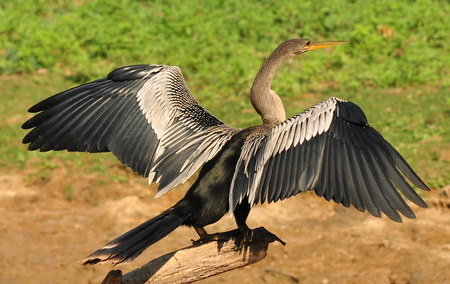 Birds are the most elusive, but we can observe them closer than ever. The hoatzins move away just enough so that you cannot catch them by extending your arm. Here we can clearly see the long feathers on their crests and the blue skin around their eyes. The white and gray herons are flying away upstream, so after a while we see them again. Although not so abundant, we also see several roseate spoonbills. In a tall tree on the river bank a couple of jaribu have built their huge nest. We also find several black vultures and caracaras digging on the beaches in search of turtle eggs. It’s mating season for turtles and although they bury their eggs in the sand, caracaras seems to have a sixth sense to find them.
Birds are the most elusive, but we can observe them closer than ever. The hoatzins move away just enough so that you cannot catch them by extending your arm. Here we can clearly see the long feathers on their crests and the blue skin around their eyes. The white and gray herons are flying away upstream, so after a while we see them again. Although not so abundant, we also see several roseate spoonbills. In a tall tree on the river bank a couple of jaribu have built their huge nest. We also find several black vultures and caracaras digging on the beaches in search of turtle eggs. It’s mating season for turtles and although they bury their eggs in the sand, caracaras seems to have a sixth sense to find them.
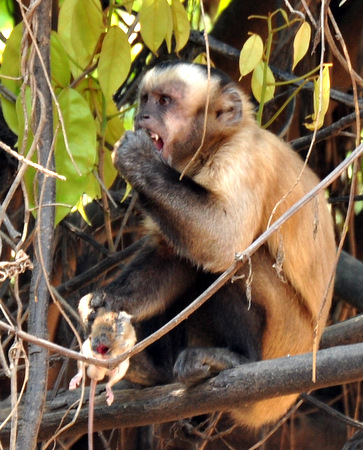 When Luis maneuvers the boat to approach the shore, alligators and especially capybaras remain quiet, watching us. Even families with young capybaras don’t hide. At most, they get up and move upstream a little or move away some from the water. We're not talking about seeing one alligator or one capybara every 10 minutes. We are talking about seeing several at once, almost continuously. On one occasion a large capybara frightens a small caiman stepping on it. After seeing a few dozen of each, we only pay attention if there is something remarkable, like baby capybaras or alligators fighting. It's amazing how alligators are confused with tree roots and how they hide in the water. Where you see one, for sure there is more.
When Luis maneuvers the boat to approach the shore, alligators and especially capybaras remain quiet, watching us. Even families with young capybaras don’t hide. At most, they get up and move upstream a little or move away some from the water. We're not talking about seeing one alligator or one capybara every 10 minutes. We are talking about seeing several at once, almost continuously. On one occasion a large capybara frightens a small caiman stepping on it. After seeing a few dozen of each, we only pay attention if there is something remarkable, like baby capybaras or alligators fighting. It's amazing how alligators are confused with tree roots and how they hide in the water. Where you see one, for sure there is more.
The monkeys are more difficult to spot but we get to see 3 different species. Judit first discovers a howler male peacefully sleeping on a branch while warming up in the morning sun. Later, in different parts of the river we find two groups of yellow monkeys. They are curious and move from branch to branch to approach the boat, getting as close as 4 feet. We suspect that's partly because some tour operators offer bananas to attract them. However, it is clear they are not afraid, because they even drink from the river upside down, holding hands, feet and tail of the branches, very close from us. One group is accompanied by a few capuchin monkeys, a little bigger and more reserved. Even so, we can see them clearly from the boat. Looking at this group we have one of the highlights of the tour. One of them hunts a mouse and eats it in front of us. The scene is pretty wild, obviously.
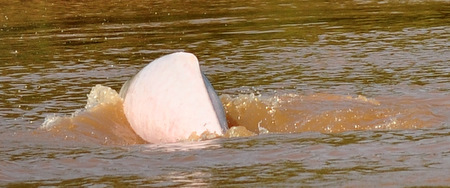 We trace the river upstream to a deeper section where we find a pod of pink dolphins. Although there are other pink dolphins in the Amazon and its tributaries, this one is endemic to Bolivia. When they are older, parts of their body turn pink. As we see that Luis and another guide get into the water, we jump in too. We only have 50% chances that the caiman nearby chooses us for lunch... However, the dolphins only get a few yards from us.
We trace the river upstream to a deeper section where we find a pod of pink dolphins. Although there are other pink dolphins in the Amazon and its tributaries, this one is endemic to Bolivia. When they are older, parts of their body turn pink. As we see that Luis and another guide get into the water, we jump in too. We only have 50% chances that the caiman nearby chooses us for lunch... However, the dolphins only get a few yards from us.

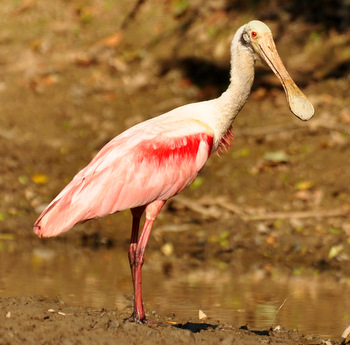 In the evening Santa Rosa is deserted. Everybody is at the jocheo, a kind of local rodeo. Before dusk we go to see a couple of rides, one of them quite spectacular. The rider climbs on the back of a giant ox in a quite peculiar way. He sits with his back towards the horns, holding his feet around the neck of the beast and his hands to the rope tied around the body. When the ox reduces its shaking and jumping, the rider snatches the ribbon tied around the neck, which is the goal.
In the evening Santa Rosa is deserted. Everybody is at the jocheo, a kind of local rodeo. Before dusk we go to see a couple of rides, one of them quite spectacular. The rider climbs on the back of a giant ox in a quite peculiar way. He sits with his back towards the horns, holding his feet around the neck of the beast and his hands to the rope tied around the body. When the ox reduces its shaking and jumping, the rider snatches the ribbon tied around the neck, which is the goal.
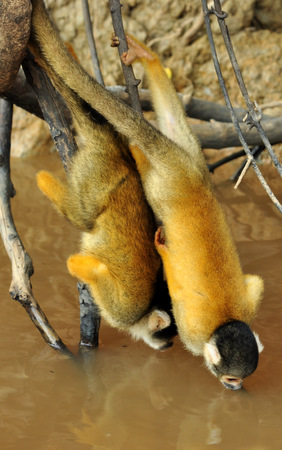
In short, a fantastic boat ride through the Reserve, teeming with wildlife, both in variety and quantity. Also, surprisingly, little elusive, which allows observing it very closely. Similarly, the second half of the distance from San Borja to Santa Rosa is full of wildlife and is very entertaining. After these two experiences and knowing the exorbitant prices of the tours in Madidi, we change our minds and we decide not to go. The Pampas del Yacuma Protected Municipal Area, although it is an different ecosystem from Madidi, has been enough to satisfy our demands. It's much recommended.
Go to top
August 31, 2011: Santa Rosa del Yacuma
 At 6:30 AM we are ready to start loading the bikes. Just when we leave the room, we hear a terrifying thunder. We stare at each other in disbelief. We have no time to say a word before the rain starts to fall. More thunder. The rain intensifies. With this rain, the dirt road to Rurrenabaque will be so muddy that we delay our departure one day.
At 6:30 AM we are ready to start loading the bikes. Just when we leave the room, we hear a terrifying thunder. We stare at each other in disbelief. We have no time to say a word before the rain starts to fall. More thunder. The rain intensifies. With this rain, the dirt road to Rurrenabaque will be so muddy that we delay our departure one day.
We spend the day organizing the next stages and writing the recent stories. In the afternoon we go again to the jocheo by motorcycle taxi, but this time we pay to see it from privileged shaded seats and from the beginning. We witness a total of 5 rides. The star of the day is a guy who goes out with his red and yellow cape to fight each bull even before it has gotten rid of its rider. Our star gets 3 of the 5 red ribbons from the monsters, either mounting them when they are tired or distracting them with the cape and approaching from the side. It’s with the last one that he ends his performance when he stands atop of a huge bull, after having ridden it for a while. The audience applauds and cheers as he gets off jumping to the ground.
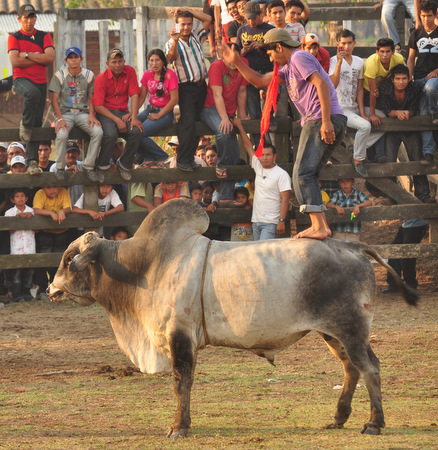 A high pole greased with cow fat is in the center of the arena. It still has all the accessories for mounting hanging from th e top. The first to climb it keeps them. There have been several attempts, but most only make it to half way up. When we leave, the prizes are still up there.
A high pole greased with cow fat is in the center of the arena. It still has all the accessories for mounting hanging from th e top. The first to climb it keeps them. There have been several attempts, but most only make it to half way up. When we leave, the prizes are still up there.
In Santa Rosa's plaza the one-men-band play their keyboards and sing at full blast. Luckily, on the terrace we are seating, there is a power failure and it just gives us enough time to drink up the beer; with some urgency though, because we are right in front of one of the speakers. Here we see a new record: 6 people on a motorbike. Two kids on the gas tank, daddy, another kid sandwiched between daddy and mum, mum and a baby hangging from mum's arm. Six on a bike! This is transport efficiency.
Go to top
From September 1 to 3, 2011: From Santa Rosa to Rurrenabaque
We shipped our box from Trinidad to Rurre, so now we have to go to Rurre to pick it up. We tried yesterday calling the shipping office in Rurre but they never picked up.
The road from Santa Rosa to Rurrenabaque is horrible. You can choose between rocks, potholes, sand or any combination of the 3. In addition, there are few animals, in part due to the traffic (this is the road to Riberalta, Guayaramerín and Cobija). Still we can see a toucan and several other birds. The first day we cover the distance to Reyes and sleep there.
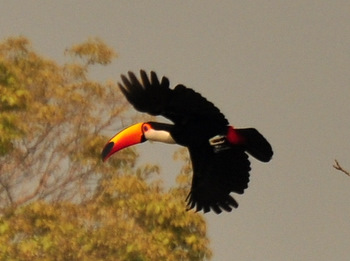 The next day, although the terrain improves some it’s still bad. In the last few miles before Rurrenabaque, we can see the hills of the Madidi National Park, across the Beni River. Rurre is the gateway to Madidi and also origin of most tours to the Pampas del Yacuma. Tour operators, hotels and travel agencies are one next to the other on the downtown streets. The concentration of tourists is high. Nevertheless, we thought it was going to be higher. We take advantage of some of the touristy facilities and on a coffee shop terrace we make plans for our next destination, Puerto Maldonado in Perú, and how to get there. In the end we're going by bus, on a journey that promises to be epic. It’s only 20 hours on a bus without air conditioning on dusty roads. Some people recommended not doing it by bike, as there is no interest for most of the trip which is consistent with other riders’ blogs. Out initial plan was to ride to Ixiamas and cross the Madidi National Park towards the village of Alto Madidi and then on to Puerto Heath, where there is a military checkpoint from where you can cross by boat to Puerto Pardo in Perú and then to Puerto Maldonado, still by boat. Although our fantastic map shows a road from Alto Madidi to Puerto Heath, that road is only a project and currently the road ends at Alto Madidi. An alternative to get to Puerto Heath is to go by road to Cobija and from there to Chivé close to Puerto Heath, also by road. From Chivé you can go to Puerto Heath by boat. Another option is to go on a boat upstream the Madre de Dios River from Riberalta or El Triangulo (at the fork to Cobija on the road to Riberalta) to Puerto Heath. Someone told us about another option, a secondary road that goes to Soberanía and splits from the main road from Cobija to Chivé. This secondary road crosses the border with Perú and gets to Mavila, on the road from Iñapari to Puerto Maldonado. From Cobija there is also a road that goes to Bolpebra, on the triple border between Bolivia, Brazil and Perú. From Bolpebra you can cross over Iñapari. However, a better alternative is to cross from Cobija to Epitaciolândia in Brazil and use the paved road towards Assis Brazil; from there you can cross to Iñapari in Perú. This last option is the one we take. To cross to Brazil, you have to use the Epitaciolândia bridge to go through immigration, not the bridge to Brasileia. The locations with immigration offices in Bolivia are: Rurre, Cobija and Bolpebra. In Brazil: Epitaciolândia and Assis Brasil. In Perú: Iñapari and Puerto Maldonado.
The next day, although the terrain improves some it’s still bad. In the last few miles before Rurrenabaque, we can see the hills of the Madidi National Park, across the Beni River. Rurre is the gateway to Madidi and also origin of most tours to the Pampas del Yacuma. Tour operators, hotels and travel agencies are one next to the other on the downtown streets. The concentration of tourists is high. Nevertheless, we thought it was going to be higher. We take advantage of some of the touristy facilities and on a coffee shop terrace we make plans for our next destination, Puerto Maldonado in Perú, and how to get there. In the end we're going by bus, on a journey that promises to be epic. It’s only 20 hours on a bus without air conditioning on dusty roads. Some people recommended not doing it by bike, as there is no interest for most of the trip which is consistent with other riders’ blogs. Out initial plan was to ride to Ixiamas and cross the Madidi National Park towards the village of Alto Madidi and then on to Puerto Heath, where there is a military checkpoint from where you can cross by boat to Puerto Pardo in Perú and then to Puerto Maldonado, still by boat. Although our fantastic map shows a road from Alto Madidi to Puerto Heath, that road is only a project and currently the road ends at Alto Madidi. An alternative to get to Puerto Heath is to go by road to Cobija and from there to Chivé close to Puerto Heath, also by road. From Chivé you can go to Puerto Heath by boat. Another option is to go on a boat upstream the Madre de Dios River from Riberalta or El Triangulo (at the fork to Cobija on the road to Riberalta) to Puerto Heath. Someone told us about another option, a secondary road that goes to Soberanía and splits from the main road from Cobija to Chivé. This secondary road crosses the border with Perú and gets to Mavila, on the road from Iñapari to Puerto Maldonado. From Cobija there is also a road that goes to Bolpebra, on the triple border between Bolivia, Brazil and Perú. From Bolpebra you can cross over Iñapari. However, a better alternative is to cross from Cobija to Epitaciolândia in Brazil and use the paved road towards Assis Brazil; from there you can cross to Iñapari in Perú. This last option is the one we take. To cross to Brazil, you have to use the Epitaciolândia bridge to go through immigration, not the bridge to Brasileia. The locations with immigration offices in Bolivia are: Rurre, Cobija and Bolpebra. In Brazil: Epitaciolândia and Assis Brasil. In Perú: Iñapari and Puerto Maldonado.
In Rurre´s main plaza there is a small fair of crafts and regional products. We talk for a while with the producers of cocoa. They cultivate 2 types, the mixed and Creole, the latter with the highest percentage of fat and more appreciated by European markets.
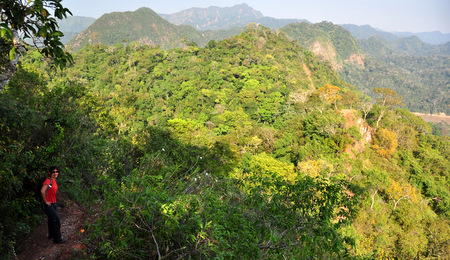 On the morning of day 3, we climb to the Rurre lookout on a hill a short distance from town. From there you can see the Beni River, the village on its shores and the mountains full of vegetation on the other side. We spend the day reading and writing, preparing for the big trip tomorrow. We meet a girl from Spain that works for the Bolivian National Parks taking pictures of wildlife. She was just coming out of Madidi and she saw nothing there, confirming our suspicions.
On the morning of day 3, we climb to the Rurre lookout on a hill a short distance from town. From there you can see the Beni River, the village on its shores and the mountains full of vegetation on the other side. We spend the day reading and writing, preparing for the big trip tomorrow. We meet a girl from Spain that works for the Bolivian National Parks taking pictures of wildlife. She was just coming out of Madidi and she saw nothing there, confirming our suspicions.
Go to top
From September 4 to 5, 2011: From Rurre to Cobija and Epitaciolândia
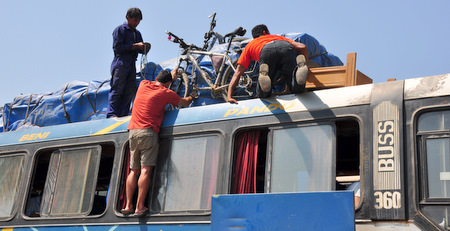 At 10 AM we show up at the Rurre bus terminal. Half an hour later our bus appears. After the usual "there is no room for the bikes", we manage to convince the baggage guys of the bus to put them on the roof, with the multitude of packages that are already there. They tie the bikes with a rope and pull them up from the roof.
At 10 AM we show up at the Rurre bus terminal. Half an hour later our bus appears. After the usual "there is no room for the bikes", we manage to convince the baggage guys of the bus to put them on the roof, with the multitude of packages that are already there. They tie the bikes with a rope and pull them up from the roof.
 The trip is as hard as we imagined. After a few hours we don´t know how to sit. The music on the bus speakers is so distorted due to the high volume that it’s hard to recognize. In addition, it´s mixed with the blaring radio of the passenger to our left. At least we choose the shade side of the bus. After Reyes and Santa Rosa, we enter an infinite plain with little vegetation and less wildlife. As the sun sets we can see the full range of colors from bright yellow to a soft mauve, with oranges and reds in between. Once the night has fallen, a hard stop awakens us. There is another bus off the road and its crew is trying to bring it back without much success. The next stop is the Beni River, where we wait for the sun to rise and for the barge to start the workday. The other side of the Beni is in the department of Pando, the northernmost of the country. The vegetation here is much more exuberant. In areas where it has not been leveled for grazing and where it is not been burned, there are two green walls on each side of the road. Later we cross the Madre de Dios River and continue towards Cobija along burned or burning plains. After many days, we meet the asphalt again at El Porvenir, 20 mi from Cobija.
The trip is as hard as we imagined. After a few hours we don´t know how to sit. The music on the bus speakers is so distorted due to the high volume that it’s hard to recognize. In addition, it´s mixed with the blaring radio of the passenger to our left. At least we choose the shade side of the bus. After Reyes and Santa Rosa, we enter an infinite plain with little vegetation and less wildlife. As the sun sets we can see the full range of colors from bright yellow to a soft mauve, with oranges and reds in between. Once the night has fallen, a hard stop awakens us. There is another bus off the road and its crew is trying to bring it back without much success. The next stop is the Beni River, where we wait for the sun to rise and for the barge to start the workday. The other side of the Beni is in the department of Pando, the northernmost of the country. The vegetation here is much more exuberant. In areas where it has not been leveled for grazing and where it is not been burned, there are two green walls on each side of the road. Later we cross the Madre de Dios River and continue towards Cobija along burned or burning plains. After many days, we meet the asphalt again at El Porvenir, 20 mi from Cobija.
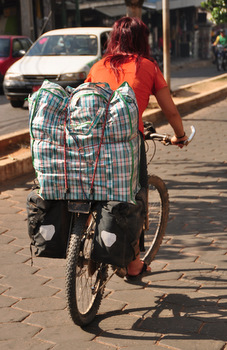 The heat in Cobija, at 3 PM, is suffocating. The 4 characters of the crew of our bus take it easy to unload the luggage. While the 2 drivers rest, "crazy" and "cholo" get on the roof of the bus and unload our bikes hanging them from a rope. We load the bags and the mega-bag (our old box has grown again in volume) on the bikes and go in search of the post office to send some crafts home. Then we head towards Epitaciolândia in Brazil. We cross to Brazil because the road to Perú on the Brazilian side is paved. Once in Epitaciolândia, on the other side of the Acre River, we look for a hotel, buy food for a couple of days and take one of the bikes to replace a rear wheel spoke that broke a few days ago. Finally, after 30 hours by bus on dirt roads, we are in Brazil.
The heat in Cobija, at 3 PM, is suffocating. The 4 characters of the crew of our bus take it easy to unload the luggage. While the 2 drivers rest, "crazy" and "cholo" get on the roof of the bus and unload our bikes hanging them from a rope. We load the bags and the mega-bag (our old box has grown again in volume) on the bikes and go in search of the post office to send some crafts home. Then we head towards Epitaciolândia in Brazil. We cross to Brazil because the road to Perú on the Brazilian side is paved. Once in Epitaciolândia, on the other side of the Acre River, we look for a hotel, buy food for a couple of days and take one of the bikes to replace a rear wheel spoke that broke a few days ago. Finally, after 30 hours by bus on dirt roads, we are in Brazil.
Go to top
© 2014 Explore Pangea. All Rights Reserved. Website
Terms
of Use.





















